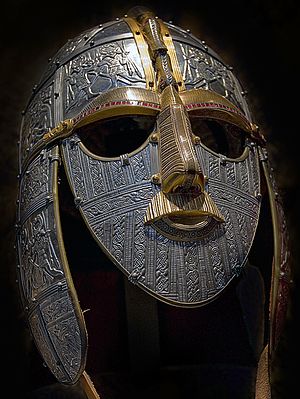Anglo-Saxon England
Anglo-Saxon England or Early Medieval England covers the period from the end of Roman Britain in the 5th century until the Norman Conquest in 1066. It consisted of various Anglo-Saxon kingdoms until 927, when it was united as the Kingdom of England by King Æthelstan (r. 927–939). It became part of the short-lived North Sea Empire of Cnut, a personal union between England, Denmark and Norway, in the 11th century. The Anglo-Saxons migrated to Britain from mainland northwestern Europe after the Roman Empire's withdrawal from Britain at the beginning of the 5th century. Anglo-Saxon history thus begins during the period of sub-Roman Britain following the end of Roman control, and traces the establishment of Anglo-Saxon kingdoms in the 5th and 6th centuries (conventionally identified as seven main kingdoms: Northumbria, Mercia, East Anglia, Essex, Kent, Sussex, and Wessex); their Christianisation during the 7th century; the threat of Viking invasions and Danish settlers; the gradual unification of England under the Wessex hegemony during the 9th and 10th centuries; and ending with the Norman Conquest of England by William the Conqueror in 1066. The Normans persecuted the Anglo-Saxons and overthrew their ruling class to substitute their own leaders to oversee and rule England. However, Anglo-Saxon identity survived beyond the Norman Conquest, came to be known as Englishry under Norman rule, and through social and cultural integration with Romano-British Celts, Danes and Normans became the modern English people. (Full article...) Selected articleLindsey or Linnuis (Old English Lindesege) was a lesser Anglo-Saxon kingdom, absorbed into Northumbria in the 7th century. It lay between the Humber estuary and the Wash, forming its inland boundaries from the courses of the Witham and Trent rivers, and the Foss Dyke between them. A marshy region south of the Humber known as the Isle of Axholme was also included. Place-name evidence indicates that the Anglian settlement known as Lindisfaras spread from the Humber coast. Lindsey means the 'island of Lincoln': it was surrounded by water and very wet land, and Lincoln was in the south-west part of the kingdom. Although it has its own list of kings, at an early date it came under external influence. It was from time to time effectively part of Deira, of the Northumbrian kingdom, and particularly later, of Mercia. Lindsey lost its independence long before the arrival of the Danish settlers. The kingdom's heyday seems to have come before the historical period. By the time of the first historical records of Lindsey, it had become a subjugated polity, under the alternating control of Northumbria and Mercia. All trace of its individuality had vanished before the Viking assault in the late ninth century. Its territories evolved into the historical English county of Lincolnshire, the northern part of which is called Lindsey. (more...) Did you know?
SubcategoriesSelected image Sutton Hoo, near Woodbridge, in Suffolk, is the site of two 6th- and early 7th-century cemeteries. One contained an undisturbed ship burial including a wealth of Anglo-Saxon artefacts of outstanding art-historical and archaeological significance, now held in the British Museum in London. Selected biography
Saint Edith of Wilton (also known as Eadgyth, her name in Old English, or as Editha or Ediva, the Latin forms of her name) was an English nun, a daughter of the 10th century King Edgar of England, born at Kemsing, Kent, in 961. Following her death in 984, she became the patron saint of her community at Wilton Abbey and churches were dedicated to her in Wiltshire and in other parts of England. Her life was written by Goscelin, and her feast day is on 16 September. (more...) Things you can do
Featured articles and lists
Related portalsWikiProjects
Associated WikimediaThe following Wikimedia Foundation sister projects provide more on this subject:
| |||||||||||||||||||














